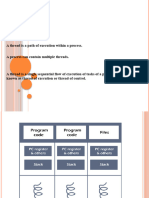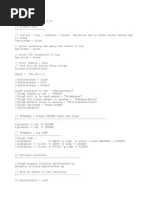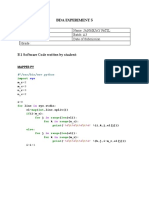Threads in Operating System
Uploaded by
Debdutta MandalThreads in Operating System
Uploaded by
Debdutta MandalThreads in Operating System
A thread is a single sequential flow of execution of tasks of a process so it is also known as thread of
execution or thread of control. There is a way of thread execution inside the process of any
operating system. Apart from this, there can be more than one thread inside a process. Each thread
of the same process makes use of a separate program counter and a stack of activation records and
control blocks. Thread is often referred to as a lightweight process.
The process can be split down into so many threads. For example, in a browser, many tabs can be
viewed as threads. MS Word uses many threads - formatting text from one thread, processing input
from another thread, etc.
Need of Thread:
It takes far less time to create a new thread in an existing process than to create a new process.
Threads can share the common data; they do not need to use Inter- Process communication.
Context switching is faster when working with threads.
It takes less time to terminate a thread than a process.
Types of Threads
In the operating system, there are two types of threads.
1.Kernel level thread
2.User-level thread.
User-level thread
The operating system
does not recognize the user-level thread. User threads can be easily implemented and it is
implemented by the user. If a user performs a user-level thread blocking operation, the whole
process is blocked. The kernel level thread does not know nothing about the user level thread. The
kernel-level thread manages user-level threads as if they are single-threaded processes?examples:
Java
thread, POSIX threads, etc.
Advantages of User-level threads
The user threads can be easily implemented than the kernel thread.
User-level threads can be applied to such types of operating systems that do not support threads at
the kernel-level.
It is faster and efficient.
Context switch time is shorter than the kernel-level threads.
It does not require modifications of the operating system.
User-level threads representation is very simple. The register, PC, stack, and mini thread control
blocks are stored in the address space of the user-level process.
It is simple to create, switch, and synchronize threads without the intervention of the process.
Disadvantages of User-level threads
User-level threads lack coordination between the thread and the kernel.
If a thread causes a page fault, the entire process is blocked.
Kernel level thread
The kernel thread recognizes the operating system. There is a thread control block and process
control block in the system for each thread and process in the kernel-level thread. The kernel-level
thread is implemented by the operating system. The kernel knows about all the threads and
manages them. The kernel-level thread offers a system call to create and manage the threads from
user-space. The implementation of kernel threads is more difficult than the user thread. Context
switch time is longer in the kernel thread. If a kernel thread performs a blocking operation, the
Banky thread execution can continue. Example: Window Solaris.
Advantages of Kernel-level threads
The kernel-level thread is fully aware of all threads.
The scheduler may decide to spend more CPU time in the process of threads being large numerical.
The kernel-level thread is good for those applications that block the frequency.
Disadvantages of Kernel-level threads
The kernel thread manages and schedules all threads.
The implementation of kernel threads is difficult than the user thread.
The kernel-level thread is slower than user-level threads
You might also like
- Unit 3 Process and Thread Kernel Data Structure100% (1)Unit 3 Process and Thread Kernel Data Structure3 pages
- Threads and Its Types in Operating SystemNo ratings yetThreads and Its Types in Operating System10 pages
- 13 Operating_System_Lec_13_Multi-TthreadingNo ratings yet13 Operating_System_Lec_13_Multi-Tthreading8 pages
- Parallel and distributed computing lec 5No ratings yetParallel and distributed computing lec 532 pages
- A Thread Is A Single Sequence Stream Within A ProcessNo ratings yetA Thread Is A Single Sequence Stream Within A Process3 pages
- Server Operating System: Muhammad Umer Iqbal, 2162069No ratings yetServer Operating System: Muhammad Umer Iqbal, 21620695 pages
- Operating Systems: Internals and Design Principles: ThreadsNo ratings yetOperating Systems: Internals and Design Principles: Threads34 pages
- Operating Systems Services: Program ExecutionNo ratings yetOperating Systems Services: Program Execution11 pages
- Lecture 6: September 20: 6.1.1 Processes Vs ThreadsNo ratings yetLecture 6: September 20: 6.1.1 Processes Vs Threads3 pages
- Etherfast Cable/Dsl Router With Qos and 8-Port Switch: User GuideNo ratings yetEtherfast Cable/Dsl Router With Qos and 8-Port Switch: User Guide53 pages
- Smart Home Technology: Hands-0N Technical DemonstrationNo ratings yetSmart Home Technology: Hands-0N Technical Demonstration64 pages
- Protocole Dhcpv4: Routing and Switching EssentialsNo ratings yetProtocole Dhcpv4: Routing and Switching Essentials13 pages
- Foundation of Cloud IoT Edge ML - Unit 6 - Week 0550% (4)Foundation of Cloud IoT Edge ML - Unit 6 - Week 053 pages
- Introduction To Voice Gateways: Understanding Cisco Unified Communications Networks and The Role of GatewaysNo ratings yetIntroduction To Voice Gateways: Understanding Cisco Unified Communications Networks and The Role of Gateways193 pages
- Solution:: 1. Find Subnet Mask and Complement Subnet Mask From The IP Address 175.231.232.116/27No ratings yetSolution:: 1. Find Subnet Mask and Complement Subnet Mask From The IP Address 175.231.232.116/273 pages
- ASA 8.3 - 8.4 Static NAT Migration Lab Guide - Lab 1.3 - My Tech WorldNo ratings yetASA 8.3 - 8.4 Static NAT Migration Lab Guide - Lab 1.3 - My Tech World7 pages
- Certified Network Associate (Mtcna) : FirewallNo ratings yetCertified Network Associate (Mtcna) : Firewall46 pages
- Download Internet Technologies Handbook Optimizing the IP Network 1st Edition Mark A. Miller ebook All Chapters PDFNo ratings yetDownload Internet Technologies Handbook Optimizing the IP Network 1st Edition Mark A. Miller ebook All Chapters PDF67 pages
- Ospf: Open Shortestpath First: Protocol ConfigurationNo ratings yetOspf: Open Shortestpath First: Protocol Configuration6 pages
- FortiADC Deployment Guide. High-Performance SSL Inspection With FortiADC and FortiGateNo ratings yetFortiADC Deployment Guide. High-Performance SSL Inspection With FortiADC and FortiGate50 pages
- Remotely Triggered Black Hole Filtering in IP Version 6 For Cisco IOS, Cisco IOS XE, and Cisco IOS XR SoftwareNo ratings yetRemotely Triggered Black Hole Filtering in IP Version 6 For Cisco IOS, Cisco IOS XE, and Cisco IOS XR Software20 pages
- Bda Experiment 5: Roll No. A-52 Name: Janmejay Patil Class: BE-A Batch: A3 Date of Experiment: Date of Submission GradeNo ratings yetBda Experiment 5: Roll No. A-52 Name: Janmejay Patil Class: BE-A Batch: A3 Date of Experiment: Date of Submission Grade5 pages
- What Are AWS Outposts?: AWS Outposts Is The New Hybrid Service Provided by Amazon Cloud ServicesNo ratings yetWhat Are AWS Outposts?: AWS Outposts Is The New Hybrid Service Provided by Amazon Cloud Services6 pages
- S02-Diseño de La Arquitectura de MicroserviciosNo ratings yetS02-Diseño de La Arquitectura de Microservicios20 pages
- Distributed Systems: University of PennsylvaniaNo ratings yetDistributed Systems: University of Pennsylvania26 pages

























































































